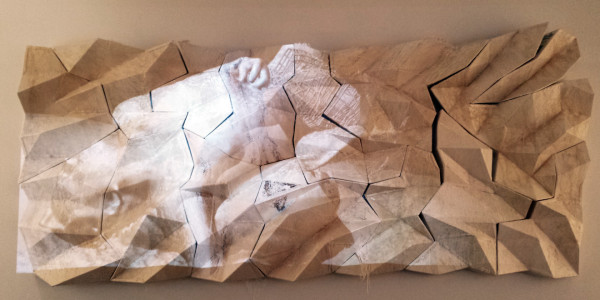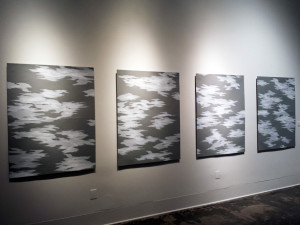
“Hi5,” an annual group exhibition featuring the work of first-year MFA students in art practice, investigates the overlap between the arts and the sciences. The pieces on display, which include work by Masako Miyazaki, Simona Fitcal, Ashley Valmere Fischer, Justin Wood and Cy Keener, experiment with form and sound to explore humanity and the natural world.
Masako Miyazaki’s abstract silkscreen prints experiment with irregular, hard-edged shapes, as well as negative space, to explore various elements of nature. Miyazaki’s work at “Hi5” consists of three series of prints —“Vapour,” “Shore” and “Flame” — each of which are expressions from a palette of just 13 shapes. “Vapour,” as its name suggests, has an ethereal quality to it thanks to Miyazaki’s use of soft-gray and white hues. “Flame” and “Shore,” conversely, employ more striking color schemes, heavy with solid black areas; “Flame” is particularly stunning thanks to Miyazaki’s use of shimmering metallic colors.

Simona Fitcal’s “Seduction of Matter” features a video projection of a pulsating, white, three-dimensional plane that undulates with the sound of a crackling audio clip. The video is projected onto three asymmetrical screens of spandex stretched across wooden frames. Fitcal’s piece, in its sheer simplicity, speaks to the nature of our existence by stripping it down to its simplest form: a collective of slowly vibrating masses, experiencing life subjectively through our own imaginations.
Ashley Valmere Fischer documents her experience with the Association for Research and Revitalization of the Industry for Ecological, Innovative and Alternative Housing through “Ardheia,” a photographic essay in which she attempts to capture the coming-together of a community in central France. In particular, the collection of photographs on display shows a group of engineers in their endeavor to build an eco-friendly housing community. Fischer’s work treads the line between vernacular photography and fine-art photography; she portrays workers in their everyday life so as to better understand the communal bonds we form with the people around us.
“The Dead Pearl Diver, 1858,” a mixed media installation by Justin Wood, tells a story by combining sculpture and digital projection. Viewers, seated several feet away from the piece, click a mouse in order to change the image that is being projected on to a jagged, 18-foot wide expanse of plastic and paper. The scenes on display are ominous and otherworldly, creating a narrative that the viewer must actively piece together. The disconnect between the sharp geometry of the sculpture and the soft, kinetic forms being projected onto it contribute to the tension in Wood’s piece.
The interactivity of Cy Keener’s piece “A Letter from the Sky”— a foreboding box made of wood and aluminum that dominates the center of the gallery space — sets the work apart from the others in the exhibition. Keener invites his viewers to walk around inside of the piece and to stand amongst the strings of LED lights illuminating the inside of the box. “A Letter from the Sky” was inspired by Keener’s earlier project “Rain Recorder,” which was an instrument used in conjunction with water sensitive paper to record rainfall outside the Stanford Art Gallery for roughly two seconds. In “A Letter from the Sky,” Keener sought to emulate rain with LED lights. By funneling the viewer into a dark metal box, the installation creates an intimate experience with droplets of light — raindrops — that appear to be frozen in time.
The works on display at “Hi5”are largely conceptual and employ a breadth of media to engage with nature and human existence. Departing from traditional art-making tools, the artists effectively touch upon themes that have been often explored but rarely understood.
“Hi5” is on view until March 1, 2015, at the Stanford Art Gallery.
Contact Eric Huang at eyhuang ‘at’ stanford.edu.
